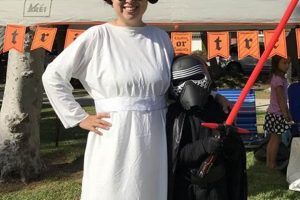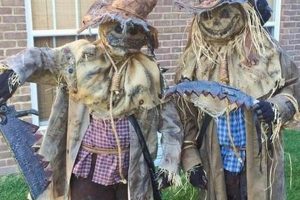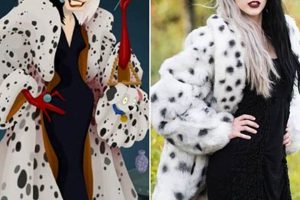A homemade recreation of the iconic Playboy Bunny outfit typically involves assembling various components to emulate the established look. This often includes a corset or bustier, bunny ears (typically crafted from wire and fabric), a bow tie, cuffs, and a fluffy tail. Stockings and heels complete the ensemble. The appeal lies in the potential for customization and cost-effectiveness compared to purchasing a pre-made costume.
The creation of such an outfit allows for a personalized interpretation of a recognizable symbol. The act of crafting the costume offers the opportunity to tailor the fit, fabric choices, and embellishments to individual preferences. Furthermore, engaging in this type of project can offer a creative outlet and a more budget-friendly option for those seeking this aesthetic. Historically, the Playboy Bunny costume has represented a specific form of feminine allure, and its reproduction, even in a do-it-yourself context, carries those connotations.
The following sections will explore specific techniques for constructing individual components of this type of costume, focusing on material selection, construction methods, and design considerations. These methods range from simple repurposing of existing clothing to more involved sewing and crafting processes.
Tips for a Successful Recreation
The following guidelines provide recommendations for crafting a visually compelling and structurally sound recreation. Attention to detail and careful planning are crucial for achieving a professional and polished result.
Tip 1: Prioritize Fit and Support. The foundation of a successful outfit resides in a well-fitting corset or bustier. Ill-fitting garments detract from the overall aesthetic. Consider professional alterations if necessary.
Tip 2: Utilize High-Quality Materials. Opt for fabrics that drape well and maintain their shape. Velvet, satin, and quality faux leather can elevate the look. Avoid materials prone to wrinkling or pilling.
Tip 3: Pay Attention to Ear Construction. The bunny ears are a focal point. Ensure the wire frame is sturdy and the fabric is securely attached. Consider adding interfacing for added structure.
Tip 4: Ensure Secure Attachment of the Tail. The tail should be firmly affixed to the garment. Utilize a strong adhesive or sew it securely in place to prevent detachment.
Tip 5: Maintain Consistency in Color Palette. Adhering to a consistent color scheme contributes to a cohesive and professional appearance. Consider classic black and white or introduce complementary hues strategically.
Tip 6: Accessorize Thoughtfully. The choice of stockings, heels, and jewelry can enhance the overall impact. Select accessories that complement the outfit without overwhelming it.
Tip 7: Plan for Comfort and Mobility. While aesthetics are important, prioritize comfort and ease of movement. The wearer should be able to move and interact comfortably.
Tip 8: Research and Reference. Study authentic representations of the outfit to inform design choices and ensure accuracy. Historical photographs and design sketches offer valuable insights.
Adhering to these guidelines will enhance the quality and visual impact of the final product, contributing to a more successful and professional outcome.
The subsequent sections will address specific challenges and provide solutions for achieving a truly refined recreation.
1. Fabric Selection
Fabric selection forms a critical foundation for any recreation of the Playboy Bunny costume. The chosen materials significantly impact the garment’s appearance, durability, and overall authenticity, directly influencing the success of the final product.
- Velvet’s Luxurious Appeal
Velvet imparts a rich, plush texture, closely resembling the original costume’s aesthetic. Its drape and light-absorbing qualities create depth and visual interest. However, velvet can be challenging to work with due to its tendency to shift during sewing and its sensitivity to ironing. Its use is therefore recommended for experienced sewers. Real-world examples range from high-end theatrical productions to meticulously crafted cosplay outfits. The implications of choosing velvet include increased material cost and a higher level of sewing skill required.
- Satin’s Silky Sheen
Satin offers a smooth, lustrous surface, providing a similar visual effect to velvet at a potentially lower cost. It drapes well and is available in a wide range of colors. However, satin can be slippery and prone to snagging. It also highlights imperfections in construction. Examples include budget-conscious costume designs or stage productions where cost is a primary concern. The consequences of selecting satin involve a balance between visual appeal and potential construction challenges.
- Faux Leather’s Structured Look
Faux leather provides a structured and durable option, particularly for the corset or bustier component. It offers a more rigid silhouette and can create a modern or edgy interpretation. However, faux leather can be less breathable and more difficult to sew than fabric. Furthermore, lower-quality faux leather may crack or peel over time. Examples include contemporary reinterpretations of the costume or situations where durability is prioritized. The implications of using faux leather include a potentially less comfortable wearing experience and the need for specialized sewing techniques.
- Cotton Blends’ Practicality
Cotton blends offer a practical and affordable alternative. They are easy to sew, readily available, and relatively durable. However, cotton blends lack the visual richness of velvet or satin. They may require embellishments or surface treatments to enhance their aesthetic appeal. Examples include beginner-friendly projects or situations where cost and ease of construction are paramount. The consequences of choosing cotton blends involve a trade-off between practicality and visual impact.
The careful evaluation of fabric properties, cost, and sewing difficulty is essential for a successful recreation. The chosen materials directly affect the garment’s overall appearance, comfort, and durability. Therefore, fabric selection represents a critical step in the costume-making process, impacting all subsequent construction decisions.
2. Ears Structure
The structural integrity of the ears is paramount in replicating the iconic Playboy Bunny aesthetic. As a defining feature, the ears’ shape, size, and stability directly influence the overall impression of the costume. A poorly constructed ear component can detract significantly from the intended visual effect. The foundational structure typically involves wire or a similar pliable yet rigid material, shaped to create the charac
teristic elongated form. This framework is then covered with fabric, often velvet, satin, or a comparable material selected for its visual appeal and texture. The attachment method to a headband or other headpiece also contributes to the ears’ stability and placement. Insufficient support or inadequate attachment can result in drooping or instability, compromising the costume’s authenticity.
Variations in ear structure are evident across different interpretations of the costume. Some designs prioritize a perky, upright appearance, achieved through heavier gauge wire and internal stiffeners. Others favor a more relaxed or floppy aesthetic, utilizing lighter materials and less rigid construction. Examples of successful ear structures include those found in professional theatrical productions, where durable materials and meticulous craftsmanship ensure both visual accuracy and long-term wear. Conversely, amateur constructions often suffer from structural weaknesses, resulting in misshapen or unstable ears. The practical implication of understanding ear structure lies in the ability to create a visually convincing and durable component, capable of withstanding wear and maintaining its intended form. Failure to account for structural requirements can lead to a diminished aesthetic and a potentially unusable costume piece.
In summary, the successful execution of the “playboy bunny diy costume” hinges significantly on the thoughtful design and construction of the ears’ structure. From material selection to attachment methods, each element plays a crucial role in achieving the desired visual effect. Challenges in this area often stem from inadequate material selection or a lack of understanding of basic structural principles. However, by prioritizing stability, shape retention, and visual accuracy, it is possible to create a compelling and convincing component that contributes significantly to the overall success of the costume. The ears’ structure is not merely an aesthetic detail; it is a fundamental element that defines the costume’s character and impact.
3. Corset Fit
The corset serves as the foundational garment for the iconic Playboy Bunny aesthetic. Its fit dictates the silhouette, influencing the overall visual impact of the costume. An ill-fitting corset compromises the desired hourglass shape, resulting in a less authentic representation. This outcome stems from a disconnect between the garment’s structure and the wearer’s body, leading to bulging, gaping, or an unflattering form. Historical examples of professional costume design emphasize precise measurements and custom alterations to achieve optimal fit. Conversely, commercially available, mass-produced corsets often lack the nuanced fit necessary for a convincing portrayal. The practical significance of a well-fitted corset lies in its ability to create the illusion of a specific body shape, contributing significantly to the costume’s success.
Achieving accurate corset fit requires careful consideration of several factors. These include ribcage circumference, waist measurement, hip circumference, and torso length. A corset that is too small restricts movement and creates discomfort, while one that is too large fails to provide adequate support or shaping. Custom alterations, such as adjusting the busk length or modifying the side seams, may be necessary to achieve a perfect fit. Examples of successful corset alterations can be found in historical costuming resources and tailoring guides. The practical application of these alterations lies in the ability to adapt a pre-made corset to individual body dimensions, ensuring a comfortable and aesthetically pleasing result.
In conclusion, the relationship between corset fit and the effectiveness of this costume is direct and undeniable. A well-fitted corset provides the necessary foundation for achieving the desired silhouette, contributing significantly to the costume’s overall success. Challenges in achieving accurate fit often stem from a lack of understanding of body measurements or a reliance on commercially available garments that do not accommodate individual body shapes. However, by prioritizing accurate measurements and employing custom alteration techniques, a compelling and authentic result can be achieved.
4. Tail Attachment
The method by which the tail is affixed to the garment in a recreation significantly impacts the costume’s overall appearance and functionality. A secure and appropriately positioned tail contributes to the authenticity and visual appeal, while a poorly attached tail can detract from the intended aesthetic and potentially compromise the wearer’s mobility or comfort.
- Sewn Attachment Integrity
A sewn tail attachment, when executed correctly, offers a robust and durable solution. This method involves directly stitching the tail to the garment, typically utilizing reinforced seams to withstand stress and prevent detachment. Examples of successful sewn attachments include costumes used in professional performances, where longevity and reliability are paramount. The implication of a secure sewn attachment is a reduced risk of the tail detaching during wear, enhancing the costume’s overall durability and appearance.
- Adhesive Bonding Limitations
Adhesive bonding, while seemingly a simpler alternative, presents several limitations in the context of tail attachment. The strength and longevity of adhesive bonds can be affected by factors such as fabric type, adhesive quality, and environmental conditions. Real-world examples of failed adhesive attachments include costumes used in amateur productions or quick, low-budget creations. The practical implication of relying on adhesive bonding is an increased risk of tail detachment, potentially leading to embarrassment or inconvenience for the wearer.
- Placement Considerations on Silhouette
The placement of the tail significantly influences the overall silhouette of the costume. An incorrectly positioned tail can disrupt the intended visual balance and detract from the desired aesthetic. Historical examples and design guides emphasize the importance of positioning the tail at the center back, just above the natural curve of the buttocks. The implications of correct placement extend beyond mere aesthetics, contributing to a more flattering and visually appealing representation of the Playboy Bunny archetype.
- Material Compatibility for Durability
The materials used for both the tail and the garment to which it is attached must be compatible to ensure a secure and lasting bond. Incompatible materials can lead to detachment or damage over time. Examples of successful material pairings include velvet or satin tails sewn onto a durable corset fabric. The practical consequence of prioritizing material compatibility is a more robust and long-lasting costume, capable of withstanding wear and maintaining its intended appearance.
Ultimately, the chosen method for tail attachment represents a critical design decision in the crafting process. While various options exist, a secure and appropriately positioned tail is essential for achieving a successful and visually compelling recreation. Considerations of durability, aesthetics, and material compatibility must guide the selection process to ensure a lasting and satisfying outcome.
5. Accessory Coordination
Accessory coordination is a pivotal element in the successful recreation of a specific look. The selection and arrangement of complementary items contribute significantly to the overall aesthetic, enhancing the visual impact and authenticity of the final result. The integration of appropriate accessories transforms a basic ensemble into a cohesive and recognizable portrayal.
- Hosiery Selection and Visual Harmony
The choice of hosiery directly affects the overall visual harmony. Sheer stockings, for example, contribute to a classic, understated aesthetic, while opaque tights offer a more modern interpretation. Garters or suspenders, if incorporated, should align with the overall color palette and style to maintain visual cohesion. Examples of successful hosiery coordination include pairing black seamed stockings with a black corset for a traditional look. Conversely, mismatched or ill-fitting hosiery detracts from the intended visual effect, disrupting the costume’s authenticity.
- Footwear Style and Proportional Balance
Footwear style must complement the overall design. High heels, particularly stilettos or pumps, are frequently associated with the aesthetic, contributing to a heightened sense of glamour. However, the heel height and style should be proportionate to the wearer’s height and the overall silhouette to maintain balance. Examples include pairing classic black pumps with a short skirt or dress. Inappropriate footwear, such as bulky boots or casual sandals, undermines the intended effect and disrupts the costume’s visual integrity.
- Jewelry Integration and Subtlety
Jewelry should be integrated with restraint and subtlety. Simple, elegant pieces, such as a delicate necklace or understated earrings, enhance the overall look without overwhelming it. Excessive or garish jewelry distracts from the central elements of the costume, diminishing its visual impact. Examples of appropriate jewelry integration include wearing a single strand of pearls or small diamond studs. Overly elaborate or distracting jewelry pieces, such as large statement necklaces or dangling earrings, detract from the costume’s intended effect.
- Glove Design and Stylistic Consistency
Gloves, if incorporated, must align with the overall stylistic direction. Long gloves, extending to the elbow or beyond, contribute to a classic, sophisticated aesthetic. Short gloves, conversely, offer a more modern or playful interpretation. The material and color of the gloves should complement the other accessories to maintain visual consistency. Examples of successful glove integration include pairing black satin gloves with a black corset and stockings. Mismatched or ill-fitting gloves disrupt the costume’s harmony and undermine its intended effect.
The strategic selection and arrangement of accessories are vital for achieving a polished and convincing portrayal. Each accessory contributes to the overall aesthetic, enhancing the visual impact and authenticity. Careful consideration of style, color, proportion, and integration is essential for creating a cohesive and visually compelling outcome.
6. Overall Silhouette
The overall silhouette constitutes a critical aspect of any attempt to recreate a specific aesthetic. Within the context of a homemade version, the silhouette dictates the immediate visual recognition and adherence to established design principles. It’s the first, and arguably most impactful, element perceived by an observer.
- Torso Shaping and Hourglass Illusion
The torso shaping, primarily achieved through a corset or similar garment, directly contributes to the desired hourglass silhouette. The degree of waist cinching and bust enhancement determines the accuracy of this visual representation. Examples include historical costuming practices where corsets were meticulously fitted to achieve specific body shapes. The implications of this shaping extend to the overall perceived authenticity of the recreation.
- Leg Emphasis and Proportionality
The perceived length and shape of the legs, often emphasized through the choice of footwear and hosiery, contribute significantly to the silhouette. High heels, for example, elongate the legs and alter the posture, creating a specific visual effect. Considerations of proportionality between the torso and legs are crucial for maintaining a balanced and aesthetically pleasing silhouette. Examples include fashion photography where strategic posing and clothing choices manipulate the perceived leg length. A lack of attention to leg emphasis can disrupt the overall balance and detract from the intended silhouette.
- Ear Placement and Head-to-Body Ratio
The placement and size of the bunny ears influence the head-to-body ratio and contribute to the overall visual impression. Ears that are too large or positioned incorrectly can create a disproportionate and unbalanced silhouette. Examples can be found in character design where careful attention is paid to the size and placement of distinguishing features. Accurate ear placement contributes to a more harmonious and recognizable silhouette.
- Tail Position and Rear Profile
The tail’s placement and size is central to the “playboy bunny diy costume” silhouette. The position of it alters rear profile and ensures the design to be consistent with the costume. The incorrect placement results in visual disturbance of the costume and distracts the viewer. The importance of tail position leads to a perfect recreation
These elements, working in concert, determine the success of achieving the intended silhouette. A failure to consider any one of these factors can compromise the overall visual effect and detract from the recognizability. Therefore, meticulous attention to detail and a comprehensive understanding of silhouette principles are essential for an effective creation.
Frequently Asked Questions Regarding DIY Playboy Bunny Costume Construction
This section addresses common inquiries and misconceptions surrounding the creation of a homemade version, providing clarity on essential aspects of the process.
Question 1: What are the fundamental components required for a basic construction?
The essential elements include a corset or bustier, bunny ears (typically crafted from wire and fabric), a tail (often made of faux fur or similar material), a bow tie, cuffs, hosiery, and suitable footwear. Each element contributes to the overall visual representation.
Question 2: What materials are most suitable for crafting durable and visually appealing bunny ears?
Durable options include sturdy gauge wire for the frame, interfacing for structure, and velvet or satin for the outer covering. The choice depends on desired aesthetic and budget. Careful material selection enhances both the appearance and longevity of the ears.
Question 3: How can a secure and professional-looking tail attachment be achieved?
Sewing the tail directly to the garment with reinforced seams is the most reliable method. Adhesive bonding is generally discouraged due to its potential for failure. Placement should be centered and high enough to avoid dragging or distortion.
Question 4: What are the key considerations for ensuring a properly fitted corset?
Accurate body measurements, including bust, waist, and hip circumference, are essential. Adjustments to the busk length, side seams, or lacing may be necessary to achieve a comfortable and flattering fit. Professional alterations are recommended for complex adjustments.
Question 5: How should accessories be coordinated to enhance the overall effect?
Accessories should complement the costume’s color palette and style. Simple, elegant jewelry and appropriate footwear enhance the look without overwhelming it. Consistency in design elements contributes to a cohesive and visually appealing final product.
Question 6: What steps can be taken to ensure the costume is comfortable to wear for extended periods?
Prioritize breathable fabrics, avoid overly restrictive corsets, and ensure that all components are properly fitted. Padding or lining can be added to prevent chafing or discomfort. Comfort should be a primary consideration alongside aesthetics.
Achieving a successful recreation requires meticulous attention to detail, careful planning, and a commitment to quality craftsmanship. Understanding the nuances of each element contributes to a more polished and authentic result.
The next section will explore advanced techniques and design considerations for those seeking to further refine their skills.
Conclusion
This exploration of crafting a “playboy bunny diy costume” has detailed critical aspects from fabric selection and ear construction to corset fitting and accessory coordination. A comprehensive understanding of these elementssilhouette considerations, tail attachment methods, and material propertiesis paramount. A successful recreation hinges not only on replicating the visual elements but also on achieving a durable, well-fitted, and aesthetically pleasing final product.
The discussed techniques provide a foundation for crafting a recognizable outfit. The information allows for informed design choices and skillful execution, which results in a compelling and authentic portrayal. Diligent application of these guidelines facilitates both visual impact and wearable functionality.







